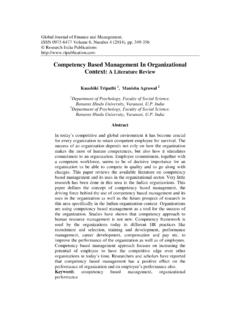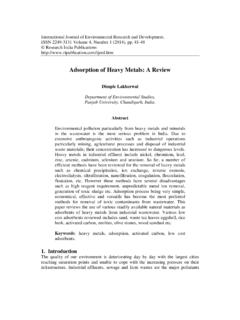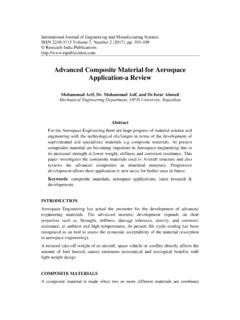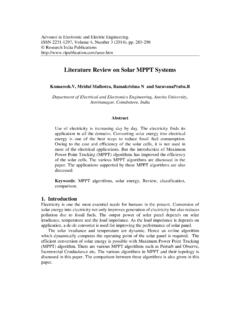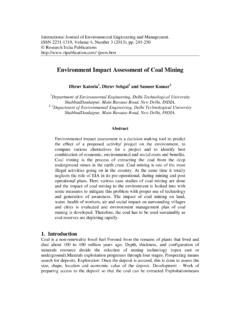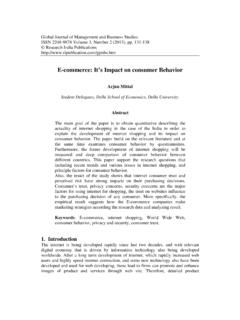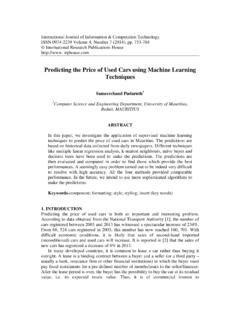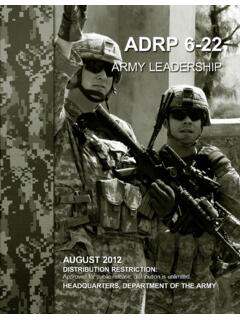Transcription of Leadership Management: Principles, Models and Theories
1 Global Journal of Management and Business Studies. ISSN 2248-9878 Volume 3, Number 3 (2013), pp. 309-318 Research India Publications Leadership Management: Principles, Models and Theories Dr. Manoj Kumar Sharma and Miss. Shilpa Jain 1 Assistant Professor, Bus. Admn., Commerce, ( ) College, Falna Dist. Pali, Rajasthan. E-mail: 2 Student- Commerce, ( ) College, Falna Dist. Pali, Rajasthan. Abstract Leadership and management must go hand in hand. They are not the same thing. But they are necessarily linked, and complementary. Any effort to separate the two is likely to cause more problems than it , much ink has been spent delineating the differences. The manager s job is to plan, organize and coordinate. The leader s job is to inspire and motivate.
2 In his 1989 book On Becoming a Leader, Warren Bennis composed a list of the differences: (a) The manager administers; the leader innovates. (b) The manager is a copy; the leader is an original. Keywords: Leadership , Management, Gurus ETC. 1. Concepts of Leadership I used to think that running an organization was equivalent to conducting a symphony orchestra. But I don't think that's quite it; it's more like jazz. There is more improvisation. Warren Bennis Good leaders are made not born. If you have the desire and willpower, you can become an effective leader. Good leaders develop through a never ending process of self-study, education, training, and experience (Jago, 1982). This guide will help you through that process. To inspire your workers into higher levels of teamwork, there are certain things you must be, know, and, do.
3 These do not come naturally, but are acquired through Dr. Manoj Kumar Sharma et al 310continual work and study. Good leaders are continually working and studying to improve their Leadership skills; they are NOT resting on their laurels. Definition of Leadership : Leadership is a process by which a person influences others to accomplish an objective and directs the organization in a way that makes it more cohesive and coherent. This definition is similar to Northouse's (2007, p3) definition Leadership is a process whereby an individual influences a group of individuals to achieve a common goal. Leaders carry out this process by applying their Leadership knowledge and skills. This is called Process Leadership (Jago, 1982). However, we know that we have traits that can influence our actions.
4 This is called Trait Leadership (Jago, 1982), in that it was once common to believe that leaders were born rather than made. While Leadership is learned, the skills and knowledge processed by the leader can be influenced by his or hers attributes or traits; such as beliefs, values, ethics, and character . Knowledge and skills contribute directly to the process of Leadership , while the other attributes give the leader certain characteristics that make him or her unique. Skills, knowledge, and attributes make the Leader, which is one of the: Four Factors of Leadership : There are four major factors in Leadership ( Army, 1983): Leader You must have an honest understanding of who you are, what you know, and what you can do. Also, note that it is the followers, not the leader or someone else who determines if the leader is successful.
5 If they do not trust or lack confidence in their leader, then they will be uninspired. To be successful you have to convince your followers, not yourself or your superiors, that you are worthy of being followed. Followers Different people require different styles of Leadership . For example, a new hire requires more supervision than an experienced employee does. A person who lacks motivation requires a different approach than one with a high degree of motivation. You must know your people! The fundamental starting point is having a good understanding of human nature, such as needs, emotions, and motivation. You must come to know your employees' be, know, and do attributes. Communication You lead through two-way communication. Much of it is nonverbal. For instance, when you set the example, that communicates to your people that you would not ask them to perform anything that you would not be willing to do.
6 What and how you communicate either builds or harms the relationship between you and your employees. Leadership Management: Principles, Models and Theories 311 Situation All situations are different. What you do in one situation will not always work in another. You must use your judgment to decide the best course of action and the Leadership style needed for each situation. For example, you may need to confront an employee for inappropriate behavior, but if the confrontation is too late or too early, too harsh or too weak, then the results may prove ineffective. Also note that the situation normally has a greater effect on a leader's action than his or her traits. This is because while traits may have an impressive stability over a period of time, they have little consistency across situations (Mischel, 1968).
7 This is why a number of Leadership scholars think the Process Theory of Leadership is a more accurate than the Trait Theory of Leadership . Various forces will affect these four factors. Examples of forces are: Your relationship with your seniors. The skill of your followers. The informal leaders within your organization. How your organization is organized. Bass' Theory of Leadership : Bass' theory of Leadership states that there are three basic ways to explain how people become leaders (Stogdill, 1989; Bass, 1990). The first two explain the Leadership development for a small number of people. These Theories are: Some personality traits may lead people naturally into Leadership roles. This is the Trait Theory. A crisis or important event may cause a person to rise to the occasion, which brings out extraordinary Leadership qualities in an ordinary person.
8 This is the Great Events Theory. People can choose to become leaders. People can learn Leadership skills. This is the Transformational or Process Leadership Theory. It is the most widely accepted theory today and the premise on which this guide is based. Total Leadership What makes a person want to follow a leader? People want to be guided by leaders they respect and who have a clear sense of direction. To gain respect, they must be ethical. A sense of direction is achieved by conveying a strong vision of the future. When people are deciding if they respect you as a leader, they do not think about your attributes, rather, they observe what you do so that they can know who you really are. They use this observation to tell if you are an honorable and trusted leader or a self-serving person who misuses authority to look good and get promoted.
9 Self-serving leaders are not as effective because their employees only obey them, not follow them. They succeed in many areas because they present a good image to their seniors at the expense of their workers. Dr. Manoj Kumar Sharma et al Principles of Leadership : To help you be, know, and do, follow these eleven principles of Leadership ( Army, 1983). The later chapters in this Leadership guide expand on these principles and provide tools for implementing them: 1. Know yourself and seek self-improvement - In order to know yourself, you have to understand your be, know, and do, attributes. Seeking self-improvement means continually strengthening your attributes. This can be accomplished through self-study, formal classes, reflection, and interacting with others. 2. Be technically proficient - As a leader, you must know your job and have a solid familiarity with your employees' tasks.
10 3. Seek responsibility and take responsibility for your actions - Search for ways to guide your organization to new heights. And when things go wrong, as they often tend to do sooner or later do not blame others. Analyze the situation, take corrective action, and move on to the next challenge. 4. Make sound and timely decisions - Use good problem solving, decision making, and planning tools. 5. Set the example - Be a good role model for your employees. They must not only hear what they are expected to do, but also see. We must become the change we want to see - Mahatma Gandhi 6. Know your people and look out for their well-being - Know human nature and the importance of sincerely caring for your workers. 7. Keep your workers informed - Know how to communicate with not only them, but also seniors and other key people.
